TL;DR
Short on time? You’ll learn practical, budget decorating ideas that make a big impact: smarter lighting, the right rug size, better furniture layout, and easy paint updates. These easy DIY home decor projects for small spaces are designed to boost comfort now while staying timeless later.
Why these interior design tips matter right now
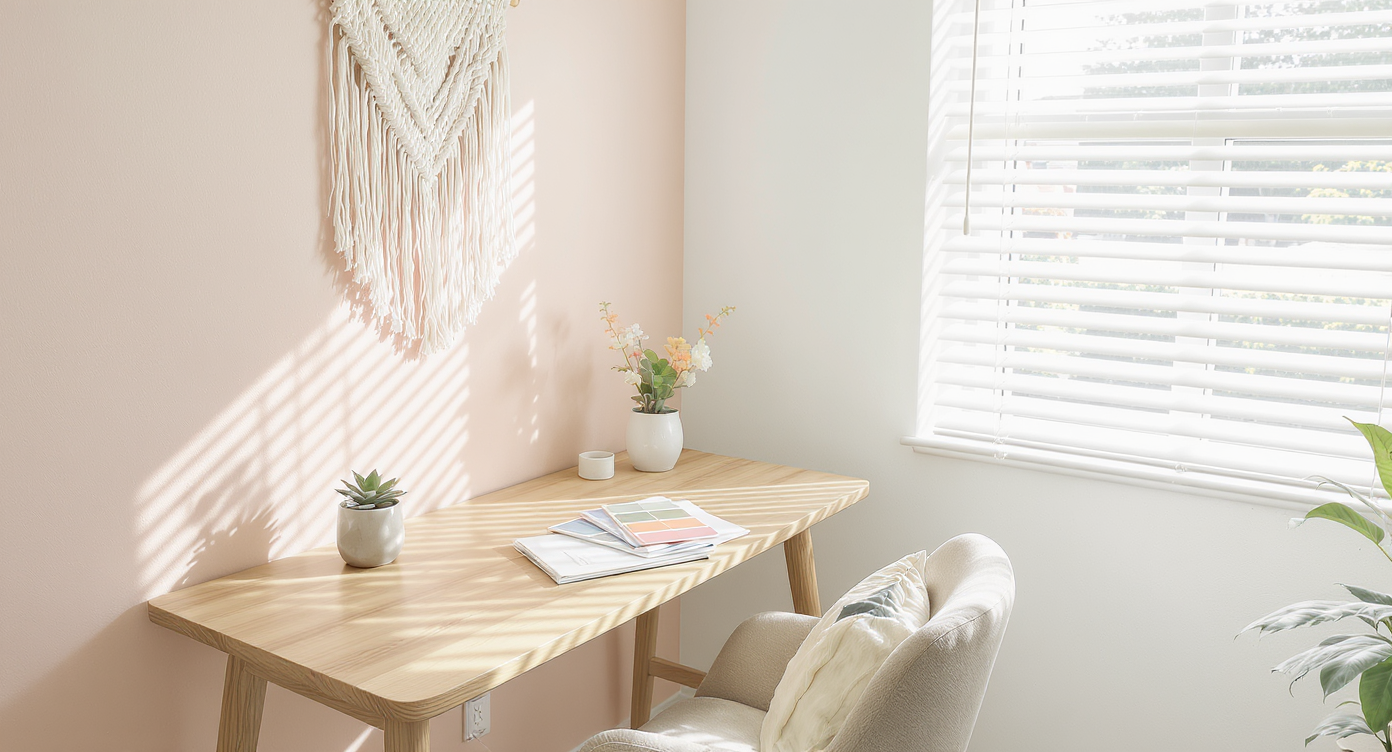
Simple DIY touches like fresh paint and handmade art create personal, budget-friendly home style.
Here’s the thing: good interior design isn’t about spending more — it’s about seeing more. DIY home decor has surged because budgets are tighter, sustainability matters, and people want homes that reflect who they are, not what an algorithm suggests. From living room layout moves to small-space hacks, these interior design tips put control back in your hands. I’ve seen renters, first-time buyers, and long-time homeowners transform rooms with a weekend of paint and a smarter lighting plan. One client swapped a too-small rug and suddenly the whole room clicked; another used a mirror to double a borrowed view. These designer-approved ideas blend creativity with clear rules of thumb so you can move fast and still get it right.
A shared philosophy for DIY home decor in 2025
Designers often advise starting with function, then layering beauty. The best budget decorating ideas share a few anchors: a coherent color story, good light at multiple levels, and furniture scale that supports circulation. DIY home decor can be stylish and sustainable when you remix what you own, shop secondhand, and invest where performance counts. Keep these short-tail keywords in mind as you plan: DIY home decor, living room layout, small-space hacks, 2025 design trends. A simple rule: if a choice improves comfort, sightlines, or light, it’s probably right.
Anecdote
A couple in a narrow row house asked why their living room felt tight despite minimal furniture. We taped out a larger rug and moved the sofa 6 inches off the wall, added a plug-in sconce, and swapped their coffee table to a rounded one. The space gained flow without a single new construction change — proof that scale and circulation beat square footage every time.
DIY Hacks & Tricks Designers Rely On
01. The Two-Tone Wall Trick (paint color)
Painting a wall in two shades elongates the room and adds quiet drama without a full repaint.
Rule of thumb: a 60/40 split — darker on the lower portion — makes ceilings feel higher and furniture look grounded.
What it is: A crisp color split that visually enlarges small rooms and adds personality.
How it works: The eye reads the darker lower band as the “base,” creating height and balance. Keep the divide straight with painter’s tape and align it with door or window trims for cohesion. Experts recommend choosing hues within the same temperature (both warm or both cool) for harmony. If you have wainscoting, color-block above or below it; in blank rooms, set the line between 36 and 42 inches from the floor.
- Mark your line with a laser level before taping.
- Use matte on the lower color to hide scuffs; satin above for light bounce.
- Match the darker tone to a rug or sofa for a pulled-together look.
Alt text: Two-tone living room wall with darker lower band and light upper paint. Caption: A 60/40 split elongates compact spaces.
02. Layered Lighting That Works (living room lighting)
Plan for three types of light — ambient, task, and accent — and at least three sources per zone to change mood on demand.
What it is: A flexible lighting plan that flatters people and spaces.
How it works: Combine a ceiling fixture with floor/table lamps and a directional source like a sconce. Designers often calculate chandelier width by adding room length + width in feet and converting to inches (a 12-by-14-foot room suggests ~26 inches). Use 2700–3000K bulbs for warmth, dimmers for control, and one statement piece for scale. In a 400-square-foot studio I visited, swapping one harsh overhead for four layered sources made evenings feel like a hotel lounge.
- Use plug-in sconces to add drama without wiring.
- Add a picture light over art for instant depth.
- Place a lamp 24–30 inches from reading seats for glare-free task light.
Alt text: Living room with layered lighting: ceiling, sconces, and lamps. Caption: Three light layers create adaptable mood.
03. The Bigger Rug Rule (rug size)
A larger rug makes the room feel intentional; aim to fit at least the front legs of major pieces on the rug.
What it is: Sizing a rug to connect your seating and ground the space.
How it works: Small rugs make furniture float. Experts recommend 8-by-10 feet minimum for most sofas and 9-by-12 feet for sectionals in medium rooms. Maintain 8–12 inches of bare floor around a rug in small rooms and 12–18 inches in larger ones. I once replaced a 5-by-8 with an 8-by-10; overnight the room stopped feeling fussy and started feeling designed.
- Tape the outline on the floor before buying.
- Choose a low-pile wool blend for high-traffic living rooms.
- Layer a 5-by-8 vintage over a large jute for texture on a budget.
Alt text: Living room seating with all front legs on a large rug. Caption: A bigger rug unifies the layout.
04. Gallery Wall That Hides Tech (gallery wall)
Blend a TV into a salon-style arrangement by treating it as one dark rectangle among many.
What it is: An art-led way to camouflage screens without cabinetry.
How it works: Keep 2–3 inches between frames and center the overall composition at about 57 inches from the floor — a museum-favorite eye level. Mix frame finishes sparingly (two metals or one wood + one metal). Add a picture light or sconce to shift the focus from the screen to the wall as a whole.
- Start with the heaviest piece off-center to avoid stiffness.
- Include one sculptural object or textile for dimension.
- Use paper templates to place before you nail.
Alt text: Gallery wall with TV blended into frames. Caption: Art clusters make tech visually recede.
05. Layout That Lets You Breathe (living room layout)
Plan for circulation: keep 30–36 inches in main pathways and 18 inches between sofa and coffee table.
What it is: A furniture arrangement that supports movement and conversation.
How it works: Float furniture off walls when possible, create U or L shapes for conversation, and align pieces with architectural features like fireplaces or windows. Side tables should be within 2–3 inches of sofa-arm height for comfort. In a narrow room, a bench or petite slipper chair keeps flow where a bulky armchair would choke it.
- Sketch zones: chatting, reading, TV, and work.
- Use nesting tables to flex for guests.
- Angle a chair 10–15 degrees to soften rigid layouts.
Alt text: Furniture plan with clear pathways. Caption: Right spacing feels instantly calmer.
06. Go Big With Art in Small Spaces (statement art)
One large piece simplifies sightlines and makes compact rooms feel confident rather than cluttered.
What it is: Overscale art that anchors a tight room.
How it works: Choose a piece that’s 2/3 to 3/4 the width of the furniture beneath. Hang so the center sits near 57 inches to keep it approachable while seated or standing. Large art reads as a focal point, which reduces the need for extra decor.
- Match colors in the art to one existing textile for cohesion.
- Float-mat posters for an elevated look on a budget.
- Try an oversized mirror to double light if art feels daunting.
Alt text: Small room with one large artwork over sofa. Caption: Scale adds clarity and confidence.
07. Utility Wall, Elevated (pegboard or rail)
A well-planned pegboard or rail turns storage into display and frees up cabinets.
What it is: A functional wall system for kitchens, entryways, or studios.
How it works: Standard pegboards have 1-inch on-center holes; mount into studs or use a French cleat for security. Curate what you hang: limit to one material family (wood or metal) and one accent color for calm. In a tiny entry, a rail with S-hooks and a slim shelf corrals daily essentials in 6 inches of depth.
- Stain wood pegs to match cutting boards for cohesion.
- Hang items by frequency: lowest for daily, highest for seldom used.
- Add a picture ledge for mail and sunglasses.
Alt text: Kitchen pegboard styled with pans and boards. Caption: Storage can be display when curated.
08. Don’t Forget the Fifth Wall (ceiling)
Color or pattern on the ceiling draws the eye up and can make low rooms feel intentional.
What it is: A ceiling treatment that completes the envelope of a room.
How it works: Use the same color as the walls for a cocooning effect in small rooms, or a ceiling 10–20 percent lighter than the walls to lift height. Subtle wallpaper hides minor imperfections and adds movement. Pendant-to-stool ratio tip: if you have four island stools, three pendants usually feel right.
- Cut sheen to flat on ceilings to minimize glare.
- Use soft blues/greens for an airy vibe; clay tones for warmth.
- Add a medallion to scale up a modest fixture.
Alt text: Room with color-washed ceiling. Caption: The “fifth wall” finishes the story.
What ties these ideas together
What ties these ideas together isn’t just frugality — it’s intention. Each project works harder than it looks: reuse, warmth, rhythm, and scale doing the quiet heavy lifting. I’ve watched a studio transform when the bed slid into a tucked alcove and a curtain created a soft “pause point.” I’ve seen a plain rental glow with pink-tinted bulbs at dusk. Small changes, big feelings — that’s the magic of design done thoughtfully.
Visualize before you DIY
Before you pick up a brush or start moving furniture, preview the choices. Tools like ReimagineHome let you test paint color, rug size, lighting placement, and art layouts on a photo of your actual room in seconds. Upload a shot, try the two-tone wall, drop in a larger rug, or mock up a gallery wall around your TV. Seeing options side by side reduces guesswork and helps you choose the palette, scale, and layout with confidence — no extra holes in the wall, no paint remorse.
Visualization Scenario
Upload your living room photo to ReimagineHome and test a 60/40 two-tone wall in three palettes, compare an 8-by-10 vs. a 9-by-12 rug under your current sofa, and preview a gallery wall template that wraps around your TV. Export your favorite mock-up and use it as your weekend project roadmap.
FAQ: People also ask
How should I layer lighting in a living room?
Use ambient, task, and accent lighting with at least three light sources per zone; 2700–3000K bulbs and dimmers create flexibility.
What size rug do I need for my living room?
Choose a rug large enough for front legs of major pieces to sit on; 8-by-10 feet fits most sofas, 9-by-12 feet suits sectionals in medium rooms.
What’s the best height to hang artwork at eye level?
Center artwork around 57 inches from the floor; this museum-favorite height works for most rooms and keeps sightlines calm.
How far should a sofa be from a coffee table?
Keep about 18 inches between the sofa edge and table for easy reach and comfortable legroom.
How do you decorate a small living room on a budget?
Prioritize paint, a larger rug, layered lighting, and one focal artwork; shop secondhand and repurpose what you own for impact without overspending.
Design that lives as beautifully as it looks
In 2025, home decorating ideas that endure share a common goal: rooms that care for the people in them. When you choose the bigger rug, hang art at a human eye level, or add one more layer of light, you’re not following trends; you’re designing for how you live. Let these rules guide you, not fence you in. Start with comfort, scale for flow, and add texture and color that feel like you. And when you’re unsure, visualize it first with ReimagineHome — then make your move.
.svg)

.svg)



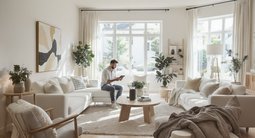
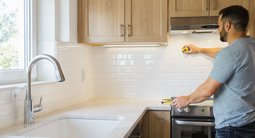

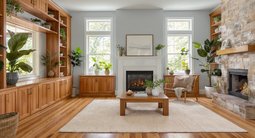
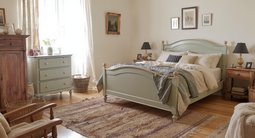



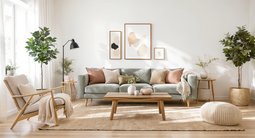


.png)